Joe Figliulo-Rosswurm*
History is what’s happening: Letter from Ferguson, MO
(What follows is somewhere between a rant and journalism, with a bit of oral history thrown in. I’m a medievalist by training so, as a former boss used to tell me, this is all new to me.)
I moved to St. Louis about a month and a half ago, following the most violent episodes in the ongoing standoff between protestors and community members of Ferguson on one hand, and an alternately terrifying and farcically ill-trained police force on the other.
The first personal experience I had of the events following Michael Brown’s murder at the hands of Darren Wilson consisted of my partner contacting me before I flew out to let me know two things: police checkpoints and blockades were expanding from St. Louis County to the City itself, and the Revolutionary Communist Party (otherwise known, in the tradition of naming Communist splinter groups after their splinterer-in-chief, as “Avakianites”) had sent cadres down from Chicago to instigate the workers’ revolution.
“Che me frega?” translates, very loosely, as “What’s it got to do with me, then, huh?” It is a typical response in Italy when a person is being asked to take responsibility for anything. I was disgusted with Brown’s killing, and with criminalization of black males in this country, more generally. But my response to the situation my first month here was something like “Che me frega?” It’s got nothing to do with me, so let me get back to writing my dissertation about class struggle in a suitably remote and foreign locale, namely fourteenth-century Tuscany.
History doesn’t work like that. And I was reminded of that on Wednesday night, when an off-duty[1] STLPD officer gunned down VonDerrit D. Myer, Jr., around the corner from my apartment.
Myer bought a sandwich from Shaw Market with some friends, and left the store.[2] At some point, he and his friends were challenged by the unidentified officer, off-duty but working for a private security company. Whatever else transpired, by the end of the subsequent encounter, Myer was dead with at least 8 bullets in him, and the officer was alive. In an eerie evocation of a scene in The Wire,[3] Missouri Rep. Jeff Roorda afterwards lamented the fact that Myer would still be alive, if only the courts had embraced a detainment measure that would keep people facing gun charges in jail pending their court date.[4] The logic of the carceral state here reaches heights undreamed of by Kafka or Orwell.
The police account of what happened has changed several times, and the only thing we know for sure at this point is that it will be quite a while before we know the full story of how VonDerrit D. Myer, Jr. died. Media accounts emphasize that Myer had previously been arrested and was facing gun charges. As a ruse of power, it’s a clever rhetorical move. The victim is always at fault because the victim is always already a criminal.
In any event, this shooting testifies to the accuracy of Antonio French’s statement: “the issue of police brutality and killer cops is not a Ferguson issue but rather an American issue.”[5]
The people in my neighborhood understand this perfectly well. After news began to spread of Myer’s murder, locals began to spontaneously gather in the area and block off the intersection of Shaw & Grand, near Compton Hill Park. After the police arrived scuffles ensued, with people shouting: “Hands up don’t shoot” and “Whose streets? OUR STREETS!”[6]
Anyone who sees this as an “explosion” of “spontaneous” rage hasn’t been paying attention. Nothing could be less spontaneous than police harassment of young black males or community rage at this fact. My partner and I were having drinks when we heard the distinct buzz of helicopters. Joking about black helicopters and the CIA, we looked out our balcony to see…. a black helicopter, circling the area of Shaw & Grand. The helicopter kept up its solitary aerial vigil all night.
Thursday was more intense. We had gone out for nightcaps only to find that the black helicopter had come back for a return visit. People had assembled at Grand and Shaw again, and at some point began marching down Grand, towards the nightlife and shopping district just past Grand and Arsenal. As we debated whether to head home or join the protest, events decided for us: squad cars, helicopters, and MetroLink security cars began howling through the neighborhood and setting up informal checkpoints on Grand.
We, along with the other bar denizens, were left to our beers and our talk. This ran the gamut from declarations of offended bourgeois propriety (“I can’t believe they are doing this here!It makes me ashamed to be St. Louisian!”) to dark talk of a conspiracy between the National Guard, FBI, and STLPD to contain any protests that might break out before the October 15 decision on whether to indict Darren Wilson. One of our fellow drinkers claimed that he was in the area just before Myer was shot, and that he saw the cop skulking in an alleyway, apparently napping, before the shooting. Soon reports arrived that people were burning American flags in public; this produced another round of self-righteous indignation on the one hand, and toasts on the other.
We ended up being stuck at the bar for several hours until squad cars stopped circling the block. The whole experience was strange: although quite close to whatever was happening on Grand, in fact we knew very little about said events and couldn’t join in, due to the absolute distance separating us from the next two blocks due to a massive police barricade and the wild discrepancies in reports on what was happening, from it being a peaceful march to something approaching a riot.
Eventually we made our way down to Grand, which was awash in police lights, broken glass, and angry-looking police officers bellowing at no one in particular to get out of the area. Snapping away on my cameraphone to document whatever was about to happen, I asked a few people about what was going on. They said that the cops had arrested several people and were trying to herd protesters together to arrest everyone, en masse. They were making their escape, and urged us to. Out of perverse curiosity, I decided I needed another pack of cigarettes, and proceeded to lead a squad car and police SUV through Tower Grove Park on a trip to the local 7-Eleven.
At the store, I found a local haranguing the clerk and the other customers about a convoluted scenario in which Myer didn’t deserve to get shot, but had to face “consequences.” The consequences of what were never clear; the clerk seemed puzzled that anyone would be so suicidal as to point a gun at the cops, but was also receptive to the idea that maybe the cops were lying. The whole neighborhood was a hive of rumor, counter-rumor, common knowledge, and general gossip of a highly political sort, yet in a diffuse and incoherent way. I made my way home, trying to process what was going on.
History, or in any case historiography, made its appearance on the scene Friday, in the form of Walter Johnson’s keynote speech at Washington University’s graduate student history conference. The conference’s theme was “the History of the Future,” and Johnson’s talk was a narrative tour-de-force, linking the deep history of St. Louis’ endemic racism and segregation with early 21st-century corporate capitalism, municipal tax farming, and the tragedy of Michael Brown’s murder.
Beginning with a quote from Walter Benjamin’s Einbahnstrasse, Johnson elaborated on white America’s peculiar fixation with black non-freedom as a necessary prequel to black freedom, and its double duty as both a subsidiary element to, and justification of, the broader American narrative of Freedom. Drawing on Barbara J. Fields’ work on the nature of American racism,[7] Johnson highlighted the many ways in which black Americans’ ghettoization and incarceration has been central to white America’s capital accumulation in the form of privatized incarceration and the destruction of black neighborhoods to build the Interstate Highway system.
Johnson’s talk cut to the bone when he linked his broader discussion of American racism to racism, St. Louis-style (such as the restrictive 1916 laws on black residential zones, and the 1917 East St. Louis race riot), and the 60-odd St. Louis County municipalities’ peculiar institution of farming their citizens for court fines. Shorn of tax revenue from corporations due to the sophistries of TIF zone regulations, County municipalities yielded to Thatcher’s injunction that “there is no alternative,” and began to milk their poorest residents for revenues. This runs the gamut from tickets for failure to place one’s garbage cans in the proper place to failure to appear for a court date because one is already incarcerated for previous traffic tickets. This tragicomic situation is the result of the fact that these municipalities are essentially indentured servants to finance capital, as a result of the vagaries of the bond market and its crucial role in financing TIF-based corporate office parks in communities such as Ferguson.
Johnson’s key link to the tragedy of Ferguson is the case of Emerson Electric, a large company whose office park Ferguson more or less funded by relinquishing property taxes. Johnson closed his tightly-argued talk with describing common sense as the “river bank of history”: we don’t know how it’s conditioning our thinking until it shifts course and leaves us high and dry, like the Mississippi when it shifts course.
All of this was much on my mind when I attended the main event of the Ferguson October[8] resistance weekend, a march from 15th and Market St. to Kiener Park, behind the Old Courthouse. The assembly was remarkable, to me, for two reasons: the absence of Black Bloc troops trying to start street battles with the cops, and the racially and ethnically variegated character of the protest community. This would, perhaps, be unremarkable, except for the fact that several people from Chicago and elsewhere whom I spoke to during the march told me that their local media has been portraying organizing efforts around the issue as a “black thing,” which it most assuredly is not. Indeed, as one Chicago native remarked, “if it is just a ‘black thing,’ then we’re in even worse trouble than I think.”
The march concluded at Kiener Park, the centerpiece of which is a statue of a runner. Given that he’s positioned facing west, away from the courthouse and the city’s legacy of slavery, I can only assume he’s engaging in one of St. Louis’ central myths, i.e., the city’s role as the gateway to the West. Or maybe the runner was exhorting us all to run, but to where? People remained in the park for much of the afternoon; Ferguson October events will continue throughout the month.
There was another standoff between cops and protesters in the Shaw neighborhood Saturday, and people were arrested during protests in Ferguson.[9] There’s sure to be more friction, especially if Darren Wilson is not indicted.
This is probably the part where I’m supposed to conclude with liberal platitudes about the relevance of history, but that seems a bit unnecessary. In St. Louis, the dead weight of the past does indeed hang over us all like a nightmare, despite the best efforts of boosters and gentrifiers to turn the downtown into an outdoor mall dyed red for the Cardinals baseball team,[10] and with its historical monuments safely sanitized by being acknowledged as part of the city’s past, and thus sterilized for daytrippers and tourists.
The clash was illustrated graphically for me on the march, as we rounded Market and turned onto Dred Scott Way (see pictures). St. Louis’ Old Courthouse, erected in 1828, fronts on Dred Scott Way, and the street is so named because he initially filed for his freedom there. The courthouse is within spitting distance of several of the old slave markets, in particular the one where the Federal Reserve Bank is now.
This visible invisibility of racism, capitalism, and hyper-segregation was a key point of Johnson’s keynote speech. Official discourse acknowledges slavery, and St. Louis’ (bad old, and now presumably buried) past of segregation, only to underline some presumed break with a (presumably egalitarian, de-segregated, and safely color-blind) present that never in fact happened. The STLPD and County municipal police will undoubtedly murder more young black males, and continue fudging facts; the myriad municipalities of the County will continue to farm their poorest residents for tax revenue and seize their liquid assets,[11] while continuing to desperately try to attract TIF-funded corporate infrastructure; we will continue to protest, because people here are sick and tired of being sick and tired.
I’ll let a neighbor of mine have the last word. Coming back from the protest, we talked to her for a bit about the Myer shooting, the march, and police repression. She told us she had lived here for 35 years, having moved from Baltimore; asked what she thought of the place and whether she wanted to move, she responded: “I don’t know where I want to go, all I know is that I fucking hate this place!”
CODA
Are you a historian and have never been to St. Louis? Really, you should go. It’s a riot of historical imagery and faded fin-de-siècle grandeur that coexists uneasily with a modern city best known for poverty, depopulation, and, now, police brutality. The Opera House features on its façade prominent quotes from Carl Schurz and Woodrow Wilson about the virtues of civic engagement, while across the street, the most prominent part of the Soldiers’ Memorial is an unattributed quote stating: “the essence of our struggle is that men be free.” Whose struggle is not specified.
*Joe Figliulo-Rosswurm is a doctoral candidate in medieval history at UCSB. His dissertation is a social history of state building and criminal courts in fourteenth-century Tuscany.
Notes
[1] It’s worth mentioning that, while technically off-duty, the cop was in uniform and, according to what STLPD Chief Dotson told reporters, he had all the “responsibilities and authority” of an on-duty cop. It seems that the lines separating police departments from mercenaries are getting blurrier and blurrier…
[2] The store manager, Berhe Beyet, has released the video, which you can watch here: http://www.dailykos.com/story/2014/10/10/1335651/-Why-does-the-St-Louis-PD-keep-changing-their-story-about-the-murder-of-VonDerrit-Myers
[3] For the relevant scene, see: http://www.youtube.com/watch?v=lzhubZiIqlQ
[4] For this, see: http://www.latimes.com/nation/la-na-st-louis-braces-after-latest-shooting-of-black-man-20141009-story.html – page=1
[5] For the French quote, see the LA Times piece referenced above.
[6] An interesting schemantic move has been made in the media coverage I’ve seen of this: while people were shouting “Whose streets? OUR STREETS!” (question//declarative, emphatic statement), media has given this as “Whose streets? Our streets?”
[7] He was referring, I believe, to her 1990 New Left Review piece: http://newleftreview.org/I/181/barbara-jeanne-fields-slavery-race-and-ideology-in-the-united-states-of-america
[8] For upcoming events, see: http://fergusonoctober.com/
[9] For ongoing protests in Ferguson, see: http://www.washingtonpost.com/national/some-st-louis-arrests-at-brown-shooting-protests/2014/10/12/3baaacd6-526d-11e4-b86d-184ac281388d_story.html
[10] Some of whose fans seem to see race-baiting as part of a night out at the old ballgame: http://deadspin.com/cardinals-fans-get-ugly-in-clash-with-ferguson-proteste-1643282285
[11] For more on this, and its nationwide character, see: http://www.washingtonpost.com/sf/investigative/2014/10/11/cash-seizures-fuel-police-spending/?hpid=z6

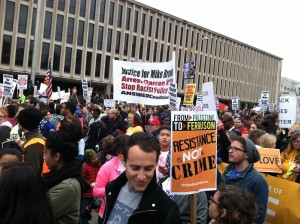
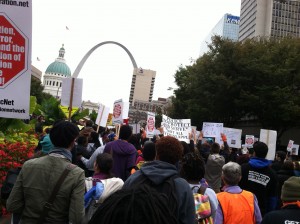
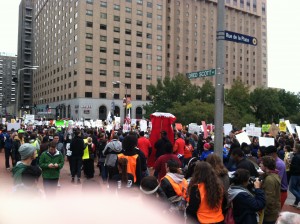
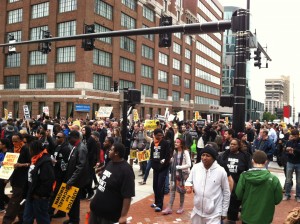
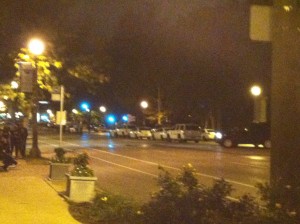
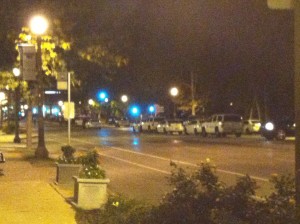
6 Thoughts on this Post
S-USIH Comment Policy
We ask that those who participate in the discussions generated in the Comments section do so with the same decorum as they would in any other academic setting or context. Since the USIH bloggers write under our real names, we would prefer that our commenters also identify themselves by their real name. As our primary goal is to stimulate and engage in fruitful and productive discussion, ad hominem attacks (personal or professional), unnecessary insults, and/or mean-spiritedness have no place in the USIH Blog’s Comments section. Therefore, we reserve the right to remove any comments that contain any of the above and/or are not intended to further the discussion of the topic of the post. We welcome suggestions for corrections to any of our posts. As the official blog of the Society of US Intellectual History, we hope to foster a diverse community of scholars and readers who engage with one another in discussions of US intellectual history, broadly understood.
In the context of Critical Theory, this quote caught my attention: “Johnson closed his tightly-argued talk with describing common sense as the “river bank of history”: we don’t know how it’s conditioning our thinking until it shifts course and leaves us high and dry, like the Mississippi when it shifts course.”
Love the metaphor. But one could argue, contrariwise and in league with Gramsci’s feel for common sense, that the widespread feeling of injustice about events in Ferguson—regardless of some of the details—is indicative of common sense at its best. Ferguson, and the events related to VonDerrit D. Myer, Jr., point toward a common, justified, and reactionary sensibility of police oppression, of the black man made criminal for his everyday actions and being. In sum, I am in fact *encouraged* by the common sensibility coming out of these events. There is a feeling that things need to change *now*, in this historical moment. – TL
@Tim Lacy:
I agree with you. I’ve been arguing about this very problem with several people here for the last week-the clash between Johnson’s empirically brilliant work, and the lasting contributions of Gramsci both to Critical Theory and to, for lack of a better phrase, an ethnography of capitalist oppression. More generally, the problem of how the basic conditions and thoughts governing peoples’ lived existence can become a vector either for breaking down these conditions, or unwittingly affirming them.
Generally speaking, I would align myself with Gramsci, and was trying to summarize, not wholeheartedly support, Johnson’s reading. Johnson’s work has, I believe, the great merit of forcing a substantive discussion about Gramsci-through-Genovese, as Gabe Winant pointed out in his review of Johnson’s latest book (https://nplusonemag.com/issue-17/reviews/slave-capitalism/). While Genovese was speaking to a specifically American context, his appropriation of Gramsci’s concepts was a major reason that non-Americanists (like myself) still eagerly use and appropriate him long after Roll Jordan Roll was published.
This was a fantastic post. It speaks to a general mood in Ferguson, one that, I believe, is replicating itself across the nation.
It’s also a reminder of the importance of studying race relations across the US. Clarence Lang has done a great deal to highlight St. Louis’ racial history, and it speaks volumes about the issue of race in American history overall.
To finish, watching the stream Sunday of the public forum about the shootings in Ferguson and St. Louis was a jarring moment. There you had a clash between older civil rights leaders and younger movement participants who are angry about what’s going on, and believe their elders haven’t done enough. There’s much to say about the dynamics of the various forces standing up for the slain Michael Brown and others who, across the nation in recent months, have died and become part of the sad history of relations between African Americans and authority figures.
Yes, Johnson specifically mentioned in his talk some of Al Sharpton’s less-than-helpful comments on the Ferguson tragedy, amounting to the assumption that young black people should, simply, vote instead of riot. I think that that speaks to a generational divide of serious proportions, not only in Ferguson but across the country and, perhaps, across racial lines, if my experience with white New Lefters has any relevance.
I really like it when this blog ventures beyond the well-meaning, but often self-absorbed worries of academia, intervening directly in contemporary debates and events. Intellectual production is part and parcel of everyday life after all. Thinking in the positive light suggested by Tim, I want to share a link to a story that shows us a glimpse of the growing sensibility of post-Ferguson solidarity, with both economic and racial implications: http://www.shareable.net/blog/solidarity-economy-organizing-in-the-wake-of-mike-brown
At the same time, I do wonder about a growing racialized divide in how people perceive what is happening in Ferguson and Saint Louis. Is the humanist faith of a “common sensibility” just that, a mere leap of faith? People often argue that the problem is that blacks and peoples of color are dehumanized and thus reduced to raging “savages” or “brutes.” But, is this really the root of the problem? A philosopher in the NYT suggested the contrary, that dehumanization is just a “symptom of the problem. The problem being precisely that black people are being seen as people — and they are seen as being threatening, and taken down, because of it.”:
http://opinionator.blogs.nytimes.com/2014/10/12/in-ferguson-and-beyond-punishing-humanity/?ref=opinion
Kahlil: I try to be hopeful, but I’m with you in wondering about a racialized divide in perceptions. My perspective on any common sensibility is entirely framed by my friends and colleagues and news feeds. I confess ignorance about the broadest perceptions. Even “common” is relative, yes? – TL